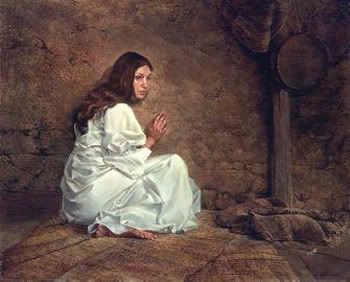
I went out to a service in the school at the Grassy Old Fen this afternoon with Minora and Minima, while Maxima had a well-earned rest from them making like Mexican jumping beans and me not being happy unless I'm grumpy about something.
We all did different workshops; I was in one ran by Vicar Cantiana on going beyond Mary as she is represented on Christmas cards, using pictures of her as they have appeared through the ages. We started with a reflection on "The Mary of your Christmas Cards", a long reflection written by Katie Baker of Hay and Stardust which started "I am the Mary of your Christmas cards", and continued later:
Do you have a picture of me 30 years after your first picture of me? Am I still dressed in blue? Are there lines on my face? Is my hair now grey?...How I aged in those three years. But am I still young in your picture?"
There were many pictures of and featuring Mary on the table, for example one showing the Holy Family as black people, which Cantiana said had kicked off a conversation on Jesus with some Afro-Carribean youths a while back. Without wanting to get into the vexed question of Jesus' actual appearance, it's not impossible that they'd grown up with, say, the chiselled Scandinavian features of Max von Sydow in The Greatest Story Ever Told, or possibly a confusing array of others in colour, black-and-white, singing, dancing and some outright blasphemous.
One of my favourite images of Mary wasn't there - The Annunciation by James Christensen (top), showing a very frightened teenage girl whose world has just been blown to pieces. We studied the Magnificat in traditional language, then Cantiana read out a "modern Magnificat" which was for me a much-needed reminder of the empowering and emancipatory themes of Mary's song even as her safe life became a thing of the past.
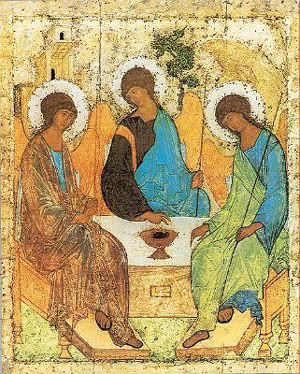
One image which caught my eye was that reproduced below - I'd be grateful if anybody could identify it, so that I could give an attribution.
There's so much going on in the image, I could have contemplated it for ages. The central figures seem to me to be Mary, at the Annunciation, opening her arms in acceptance of Jesus, who is handed over by God while the Holy Spirit blesses Mary. I was reminded of Rublev's icon of the Trinity (above), which has many meanings, but the pertinent one in relation to the below picture is that the Father, Son and Spirit occupy three of the seats at a table with four places. The place facing the viewer is unoccupied, and the beholder feels invited to occupy that place. It seemed that, as well as embracing her unique calling, Mary was representing humankind by taking her place in the life of the Trinity. I was reminded paragraph 24 of the Second Vatican council document on the church in the Modern World (Gaudium et Spes, which looks at Jesus' prayer in John 17:21-22 and speculates that he
implied a certain likeness between the union of the divine Persons, and the unity of God's sons[sic] in truth and charity. This likeness reveals that man, who is the only creature on earth which God willed for itself, cannot fully find himself except through a sincere gift of himself.Below Jesus you can just see the three crosses of Calvary, which is where Jesus is heading, and Mary with him. As Katie Baker meditation continues,
Do you know what it takes to watch your son being crucified? Some parents still do. As they pierced his side, my soul too, was pierced. Do you have a picture of me - in tears, distraught at the anguish of my son? Or am I still the Mary of your Christmas cards?There's two figures to the right of the Holy Spirit, who look like a man and a woman. The man seems to be wearing an ephod and they are raising their hands in celebration - Zecheriah and Elizabeth, parents of John the Baptist? Possibly they are representative not only of the Chosen People coming to Salvation, but also both men and women greeting a man whose attitude to gender equality would show up St Paul to be the man of his time that he was.
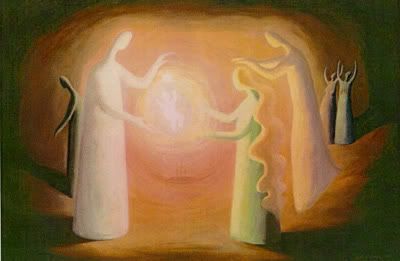
Rev'd Cantiana pointed out that the scene seems to be set in a cave, suggesting the Resurrection - much of the Gospel story in a picture.
The figure to the left, behind the Father and turning away from the whole scene, caused some debate. The prodigal son, perhaps?
The cave setting also got me thinking - a reference to Plato, perhaps? I wasn't trying to be controversial - Plato, a pagan, was referred to by St Augustine as well as Herodotus, Cicero, Tacitus and Aristotle. (Speaking to the Athenians, St Paul quotes the Greek Epimenides of Cnossos when he says that we are God's offspring.)
One of my favourite bloggers, Radagast, aptly summarises Plato's allegory of the cave:
In Plato's allegory of the cave, men who have been prisoners since childhood are kept captive in a cave where they are entertained by the shadows of animals and other creatures including men which are cast upon the cave wall in front of them by the light of a fire. Behind them, the fire burns and others carry wood and stone models in front of the fire to make their shadows dance on the cave walls. The prisoners cannot turn their heads and all of their lives have been convinced that the shadows are real, not just representations of crude models.
For a prisoner who escapes the cave, the light outside is at first unbearable. As he slowly adjusts, the shadows recede into the dimension of illusion as he realises his mistake. But on returning to the cave to announce his discovery, he is greeted with howls of disbelief. He is told that his visit to the outer world has ruined his sight so that he can no longer see straight. Keen to continue in their illusions, the prisoners would even kill him if they could lay hands on him.
While the rejoicing couple are facing the divine scene, the one turning his back to the Father is contemplating his own shadow cast upon the cave wall by the Light.
Elsewhere in the Republic, Plato touches upon an area of concern to myself and Radagast:
And therefore our politic Asclepius may be supposed to have exhibited the power of his art only to persons who, being generally of healthy constitution and habits of life, had a definite ailment; such as these he cured by purges and operations, and bade them live as usual, herein consulting the interests of the State; but bodies which disease had penetrated through and through he would not have attempted to cure by gradual processes of evacuation and infusion: he did not want to lengthen out good-for-nothing lives, or to have weak fathers begetting weaker sons; --if a man was not able to live in the ordinary way he had no business to cure him; for such a cure would have been of no use either to himself, or to the State.
Plato, unlike thinkers such as Hegel or Marx, set his theories in a mythical country. But in the real world, the multitude of sins that hide internationally under the banner of reproductive rights, often used by internationalist non-governmental organisations as a cover for population-control in the sense it was used by eugenicists, are still rolled out.
In this week's New Statesman, Clare Willson outlines tests of a PrEP (Pre-Exposure Prophylaxis) regime to prevent HIV - an awful virus that causes much suffering in all sorts of communities - when exposed to it through unprotected sex and drug-taking. This puts all sorts of people at risk - for example young girls in communities where sex with a virgin is believed to be a cure for HIV/AIDS, prostitutes and people vulnerable to lifestyles leading to drug-use.
Not only that: of the 13 countries listed in the magazine article where trials are taking place, all but four have been mentioned in John Connelly's Fatal Misconception as having been targeted and harmed by the population control/eugenics movement: Ghana, Nigeria, Cameroon, Thailand, Peru, South Africa, Kenya, and Tanzania; places where what for us would be a little thank-you gift for participating in a trial would be positively coercive for some of the individuals concerned.And the US, where, in the only cases we get clinical details of a trial, Dr Marcus Conant is prescribing PrEP "off-label" to sexually active homosexual men ( a group of people whom British eugenicist Marie Stopes referred to as exhibiting "perversion") without any thought as to the horrors that might be wrought by the viruses becoming resistant or changes in evolutionary pressures, ie having forgotten what happened with antibiotics. Other groups involved in the trial are injecting drug-users, "sexually-active women", "high-risk women" and "heterosexual couples where one member is HIV-positive". The tests indicate a mindset which wishes that the Magnificat had never been spoken or Jesus had never reached out to the marginalised.
I don't think it's controversial to say that the Gospel is a Gospel of Life. Which brings me to my last image of Mary, one you don't see on many Christmas cards, but which shows that the world is still in great need of Mary, her Magnificat and her Son. Have a good Advent.
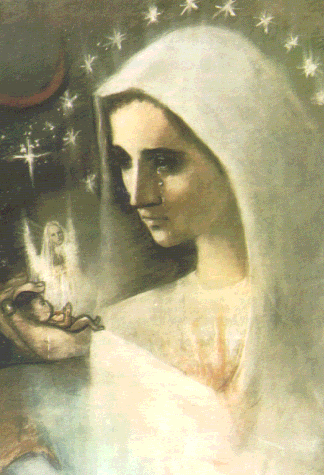





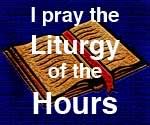


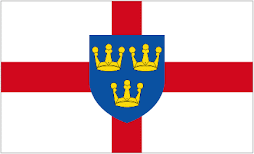


No comments:
Post a Comment
Please feel free to leave a comment - Frugal Dougal.